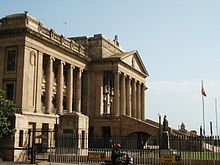
The Parliament of the Democratic Socialist Republic of Sri Lanka is the supreme legislative body of Sri Lanka. It alone possesses legislative supremacy and thereby ultimate power over all other political bodies in the island. It is modeled after the British Parliament.

Solomon West Ridgeway Dias Bandaranaike, often referred to by his initials as S. W. R. D. or S. W. R. D. Bandaranaike and known by the Sri Lankan people as "The Silver Bell of Asia", was the fourth Prime Minister of the Dominion of Ceylon, serving from 1956 until his assassination in 1959. The founder of the left-wing and Sinhalese nationalist Sri Lanka Freedom Party, his tenure saw the country's first left-wing reforms.

The Governor-General of Ceylon was the representative of the Ceylonese monarch in the Dominion of Ceylon from the country's independence in 1948 until it became the republic of Sri Lanka in 1972.
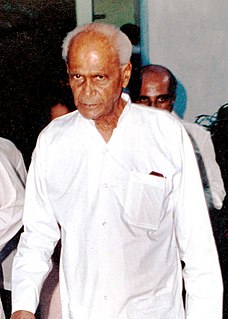
Wijeyananda Dahanayake was a Sri Lankan politician. He was the Prime Minister of Ceylon from September 1959 to March 1960.

The State Council of Ceylon was the unicameral legislature for Ceylon, established in 1931 by the Donoughmore Constitution. The State Council gave universal adult franchise to the people of the colony for the first time. It replaced the Legislative Council of Ceylon, the colony's original legislative body.
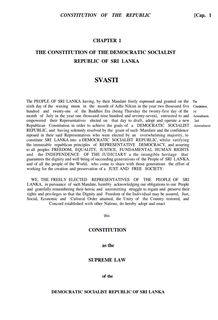
The Constitution of the Democratic Socialist Republic of Sri Lanka has been the constitution of the island nation of Sri Lanka since its original promulgation by the National State Assembly on 7 September 1978. As of August 2020 it has been formally amended 20 times.
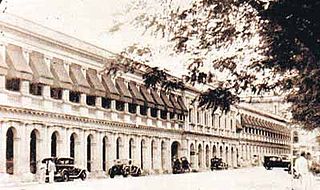
The Senate was the upper chamber of the parliament of Ceylon established in 1947 by the Soulbury Commission. The Senate was appointed and indirectly elected rather than directly elected. It was housed in the old Legislative Council building in Colombo Fort and met for the first time on 12 November 1947. The Senate was abolished on 2 October 1971 by the eighth amendment to the Soulbury Constitution, prior to the adoption of the new Republican Constitution of Sri Lanka on 22 May 1972. In 2010 there were proposals to reintroduce the Senate.
The Parliament of Ceylon was the legislative body of British Ceylon & Dominion of Ceylon established in 1947 by the Soulbury Constitution, prior to independence on 4 February 1948. Parliament replaced the State Council of Ceylon.
A national list member of parliament is a nominated member of parliament who is appointed by a political party or an independent group to the Parliament of Sri Lanka. The number of national list MPs allocated to a contesting party or an independent group depends on the proportion to their share of the national vote. A total of 29 national list MPs are appointed alongside 196 elected MPs making a total of 225 members in the parliament.

The Prime Minister of the Democratic Socialist Republic of Sri Lanka is the head and most senior member of parliament in the cabinet of ministers. It is the second-most powerful position in Sri Lanka's executive branch behind the president, who is the constitutional chief executive. The Cabinet is collectively held accountable to parliament for their policies and actions.
Srikumaradas Charles Shirley Corea was a Sri Lankan politician. He was the 9th Speaker of the Parliament and a Member of Parliament, representing Chilaw. He was a member of the United National Party of Sri Lanka.
Harindra Jayantha Corea was a Sri Lankan politician and Member of Parliament, who represented Chilaw. He was member of the United National Party of Sri Lanka. His parents were Sir Claude Corea who was renowned politician and diplomat and Lady Karmini Corea. Sir Claude was Minister of Labour in the State Council of Ceylon led by DS Senanayake, and was appointed the first ever Representative of Ceylon to the UK and was also Ceylon's first Ambassador in the United States. Harindra Corea was the brother of Nihal Corea and Chandra Corea. The family home was situated in Alfred House Gardens in Colombo.
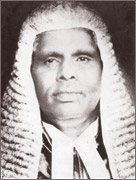
Justice Chellappah Nagalingam, KC was a leading Ceylonese judge and lawyer. He was a Judge of the Supreme Court of Ceylon and served as acting Governor-General of Ceylon in 1954. He also served as acting Chief Justice, acting Legal Secretary and Attorney General. He was the first Ceylon Tamil to be appointed to the bench of the Supreme Court of Ceylon.
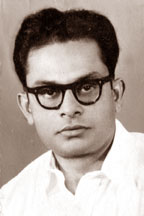
Warnakulasuriya Ichchampullige Hugh Fernando was a Sri Lankan politician born in Nainamadama. He was the Speaker of the Sri Lankan Parliament.
Sir Pattiyapathirennehelage Albert Fredrick Peries, KBE was the 4th Speaker of the Parliament of Sri Lanka. Serving as Deputy Speaker Peries first became Speaker with the sudden death of Francis Molamure, who collapsed and died while presiding over the session.
The 19th Amendment (19A) to the Constitution of Sri Lanka was passed by the 225-member Sri Lankan Parliament with 215 voting in favor, one against, one abstained and seven were absent, on 28 April 2015. The amendment envisages the dilution of many powers of Executive Presidency, which had been in force since 1978. It is the most revolutionary reform ever applied to the Constitution of Sri Lanka since JR Jayawardhane became the first Executive President of Sri Lanka in 1978.

Dewan Bahadur Chevalier Ignatius Xavier Pereira was a colonial-era Ceylonese businessman and politician.
Bernard Soysa was a Sri Lankan politician.
Jaganathan Tyagaraja was a Ceylon Tamil barrister, politician and member of the State Council of Ceylon.
